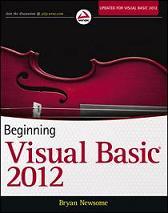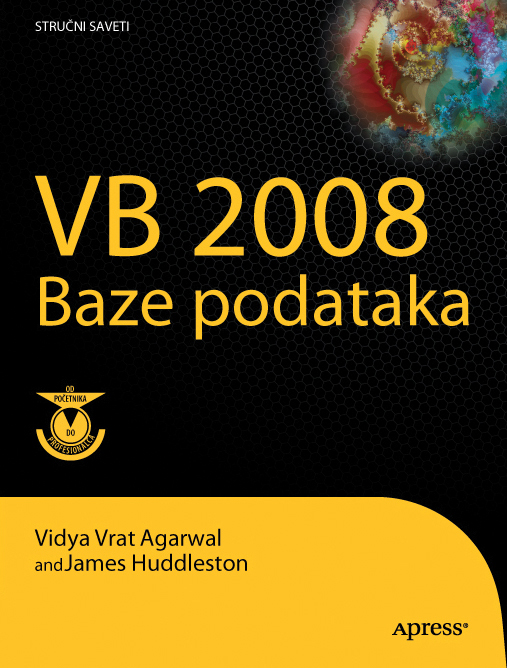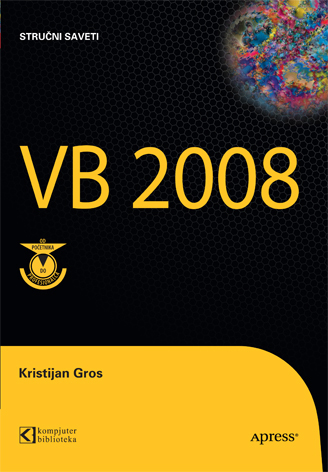
Autor: Bryan Newsome
Broj strana: 744
ISBN broj: 9781118311813
Izdavač:
WILEY ![]()
Godina izdanja: 2014.
 |
 |
 |
 |
 |
||||
Beginning Visual Basic 2012 is a must-have for programming newcomers who want to get a solid footing in one of the most important programming languages.
INTRODUCTION xxvii
Event-Driven Programming 2
Installing Visual Basic 2012 3
The Visual Studio 2012 IDE 6
The Profile Setup Page 6
The Menu 7
The Toolbars 8
Creating a Simple Application 9
Windows in the Visual Studio 2012 IDE 10
The Toolbox 14
Modified Hungarian Notation 17
The Code Editor 18
Using the Help System 23
Summary 23
Microsoft’s Reliance on Windows 28
MSN 1.0 28
The .NET Vision 29
This Sounds Like Java 30
Where Now? 30
Writing Software for Windows 31
The .NET Framework Classes 32
Executing Code 33
Common Language Runtime 34
Code Loading and Execution 35
Application Isolation 35
Security 35
Interoperability 36
Exception Handling 36
The Common Type System and Common Language Specification 37
Summary 37
Information and Data 41
Algorithms 42
What Is a Programming Language? 43
Working with Variables 44
Comments and Whitespace 46
Comments 47
Whitespace 48
Data Types 49
Working with Numbers 49
Common Integer Math Operations 50
Integer Math Shorthand 52
The Problem with Integer Math 54
Floating-Point Math 54
Other States 56
Single-Precision Floating-Point Numbers 56
Working with Strings 57
Concatenation 58
Using the Concatenation Operator Inline 59
More String Operations 59
Substrings 61
Formatting Strings 62
Localized Formatting 63
Replacing Substrings 64
Using Dates 65
Formatting Date Strings 66
Extracting Date Properties 67
Date Constants 68
Defining Date Literals 69
Manipulating Dates 70
Boolean 71
Storing Variables 71
Binary 71
Bits and Bytes 72
Representing Values 73
Converting Values 74
Methods 76
Why Use Methods? 76
Methods You’ve Already Seen 77
Building a Method 80
Choosing Method Names 83
Scope 84
Summary 86
Making Decisions 89
The If Statement 90
The Else Statement 92
Allowing Multiple Alternatives with ElseIf 92
Nested If Statements 94
Single-Line If Statement 94
Comparison Operators 94
Using Not Equal To 94
Using the Numeric Operators 96
The And and Or Operators 99
Using the And Operator 101
More on And and Or 102
String Comparison 103
Select Case 104
Case-Insensitive Select Case 108
Multiple Selections 110
The Case Else Statement 112
Different Data Types with Select Case 112
Loops 113
The For…Next Loop 113
Using the Step Keyword 116
Looping Backward 117
The For Each…Next Loop 118
The Do…Loop Loops 119
Do While…Loop 121
Acceptable Expressions for a Do…Loop 123
Other Versions of the Do…Loop 123
Nested Loops 124
Quitting Early 126
Quitting Do…Loops 128
Infinite Loops 129
Summary 130
Understanding Arrays 134
Defining and Using Arrays 134
Using For Each…Next 137
Passing Arrays As Parameters 139
Sorting Arrays 141
Going Backward 142
Initializing Arrays with Values 144
Understanding Enumerations 145
Using Enumerations 145
Determining the State 149
Setting Invalid Values 151
Understanding Constants 152
Using Constants 152
Different Constant Types 154
Structures 155
Building Structures 155
Adding Properties to Structures 158
Working with ArrayLists 159
Using an ArrayList 159
Deleting from an ArrayList 163
Showing Items in the ArrayList 166
Working with Collections 167
Creating CustomerCollection 168
Adding an Item Property 170
Building Lookup Tables with Hashtable 171
Using Hashtables 172
Cleaning Up: Remove, RemoveAt, and Clear 175
Case Sensitivity 177
Advanced Array Manipulation 179
Dynamic Arrays 179
Using Preserve 181
Summary 182
What Is XAML? 186
XAML Syntax 187
Windows Presentation Foundation 190
Creating a Rich WPF User Interface 191
Using WPF Common Controls 197
Wiring Up Events 201
Summary 205
Responding to Events 210
Building a Simple Application 217
Counting Characters 221
Counting Words 223
Creating More Complex Applications 229
Creating the Toolbar 231
Creating the Status Bar 235
Creating an Edit Box 237
Clearing the Edit Box 239
Responding to Toolbar Buttons 242
Using Multiple Forms 247
About Dialog 247
Summary 251
The MessageBox 256
Available Icons for MessageBox 256
Available Buttons for MessageBox 257
Setting the Default Button 257
Miscellaneous Options 258
The Show Method Syntax 258
Example Message Boxes 260
The OpenFileDialog Control 263
The OpenFileDialog Control 264
The Properties of OpenFileDialog 265
OpenFileDialog Methods 266
Using the OpenFileDialog Control 266
The SaveDialog Control 271
The Properties of SaveFileDialog 271
SaveFileDialog Methods 273
Using the SaveFileDialog Control 273
The FontDialog Control 276
The Properties of FontDialog 277
The Methods of FontDialog 277
Using the FontDialog Control 277
The ColorDialog Control 280
The Properties of ColorDialog 281
Using the ColorDialog Control 282
The PrintDialog Control 283
The Properties of PrintDialog 284
Using the PrintDialog Control 285
The PrintDocument Class 285
The Properties of the PrintDocument Class 285
Printing a Document 285
The FolderBrowserDialog Control 292
The Properties of FolderBrowserDialog 292
Using the FolderBrowserDialog Control 293
Summary 296
Understanding Menu Features 299
Images 300
Access Keys 300
Shortcut Keys 300
Check Marks 300
The Properties Window 301
Creating Menus 302
Designing the Menus 302
Adding Toolbars and Controls 304
Coding Menus 306
Coding the View Menu and Toolbars 310
Testing Your Code 311
Context Menus 314
Creating Context Menus 315
Enabling and Disabling Menu Items and Toolbar Buttons 318
Summary 321
Major Error Types 326
Syntax Errors 326
Execution Errors 330
Logic Errors 330
Debugging 331
Creating a Sample Project 332
Setting Breakpoints 348
Debugging Using the Watch Window and QuickWatch Dialog Box 356
Debugging with the Autos Window 358
Debugging with the Locals Window 358
Error Handling 360
Using Structured Error Handling 361
Summary 363
Understanding Objects 368
Encapsulation 369
Methods and Properties 369
Events 370
Visibility 370
What Is a Class? 371
Building Classes 371
Reusability 372
Designing an Object 373
State 374
Behavior 374
Storing State 375
Real Properties 378
Read/Write Properties 381
Auto-Implemented Properties 384
The IsMoving Method 384
Constructors 386
Inheritance 388
Adding New Methods and Properties 389
Adding a GetPowerToWeightRatio Method 392
Changing Defaults 394
Polymorphism: Scary Word, Simple Concept 395
Overriding More Methods 396
Inheriting from the Object Class 398
Objects and Structures 399
The Framework Classes 399
Namespaces 399
The Imports Statement 402
Creating Your Own Namespace 402
Inheritance in the .NET Framework 406
Summary 407
Building a Favorites Viewer 410
Internet Shortcuts and Favorites 410
Using Classes 412
Scanning Favorites 418
Viewing Favorites 426
An Alternative Favorite Viewer 428
Building a Favorites Tray 428
Displaying Favorites 429
Using Shared Properties and Methods 433
Using Shared Properties 434
Using Shared Methods 438
Understanding Object-Oriented Programming and Memory Management 439
Garbage Collection 440
Releasing Resources 441
Defragmentation and Compaction 442
Summary 443
Understanding Class Libraries 446
Creating a Class Library 446
Building a Class Library for Favorites Viewer 448
A Multitiered Application 452
Using Strong Names 453
Signing Assemblies 453
Assembly Versions 456
Registering Assemblies 456
Gacutil Utility 457
Why Is My Assembly Not Visible in the References Dialog? 457
Designing Class Libraries 457
Using Third-Party Class Libraries 459
Viewing Classes with the Object Browser 460
Summary 461
Windows Forms Controls 464
Creating and Testing a User Control 464
Exposing Properties from User Controls 468
Adding Properties 468
Exposing Methods from User Controls 470
Exposing Events from User Controls 471
Design Time or Runtime 476
Creating a Command Link Control 478
Building the Command Link Control 479
Using the Command Link Control 487
Summary 490
What You Need to Complete This Chapter’s Exercises 494
What Is a Database? 495
Database Tables 495
Primary and Foreign Keys 500
Understanding Primary Keys 500
Understanding Foreign Keys 501
Queries 502
Understanding Basic SQL Syntax 503
Using SELECT Statement 503
Using the JOIN Statement 504
Using the UPDATE Statement 505
Using the DELETE Statement 506
Using the INSERT Statement 507
Using the SQL Comment 508
Executing Queries in SQL Server 508
Summary 511
ADO.NET 516
ADO.NET Data Namespaces 516
The SqlConnection Class 517
Working with the Connection String Parameters 518
Opening and Closing the Connection 519
The SqlCommand Class 519
The Connection Property 520
The CommandText Property 520
The Parameters Collection 520
The ExecuteNonQuery Method 521
The SqlDataAdapter Class 522
The SelectCommand Property 522
Setting SelectCommand to SQL Text 523
Setting SelectCommand to a Stored Procedure 523
Using Command Builders to Create the Other Commands 524
The Fill Method 524
The DataSet Class 526
DataView 526
The Sort Property 527
The RowFilter Property 527
The Find Method 528
The ADO.NET Classes in Action 528
Data Binding 537
BindingContext and CurrencyManager 538
Binding Controls 539
Binding Examples 539
Summary 567
Creating a Dynamic Data Entities Website 571
Customizing the Design of a Dynamic Data Website 577
Page Templates 578
Entity Templates 578
Field Templates 578
Filter Templates 579
Summary 583
Thin-Client Architecture 588
Web Forms versus Windows Forms 589
Windows Forms Advantages 589
Web Forms Advantages 589
Web Applications: The Basic Pieces 590
Web Servers 590
Browsers 590
HyperText Markup Language 591
JavaScript 591
Cascading Style Sheets 591
Active Server Pages 592
Benefits of ASP.NET Web Pages 592
Special Website Files 592
Global.asax 592
Web.config 592
Development 593
Controls: The Toolbox 593
Building Websites 593
Creating a Web Form for Client- and Server-Side Processing 594
Website Locations with VS 2012 599
Performing Data Entry and Validation 602
Site Layout, Themes, and Navigation 606
Using the GridView to Build a Data-Driven Web Form 611
Summary 616
What Is Deployment? 620
ClickOnce Deployment 620
XCOPY Deployment 626
Creating a Visual Studio 2012 Setup Application 626
Customize the User Interface 632
Deploying Diff erent Solutions 633
Private Assemblies 633
Shared Assemblies 634
Deploying Desktop Applications 635
Deploying Web Applications 635
Deploying XML Web Services 635
Useful Tools 635
Summary 636
Windows 8 Application Design Principles 640
Using Touch 640
Application Commands 640
Windows 8 Controls 642
Creating your First Windows 8 App 643
Application Layout 655
Application Views 656
Screen Sizes and Orientation 656
Summary 661
LINK.
Budite prvi koji će ostaviti komentar.

Popust cena:
1500.00 rsd

Popust cena:
1500.00 rsd
© Sva prava pridržana, Kompjuter biblioteka, Beograd, Obalskih radnika 4a, Telefon: +381 11 252 0 272 |
||